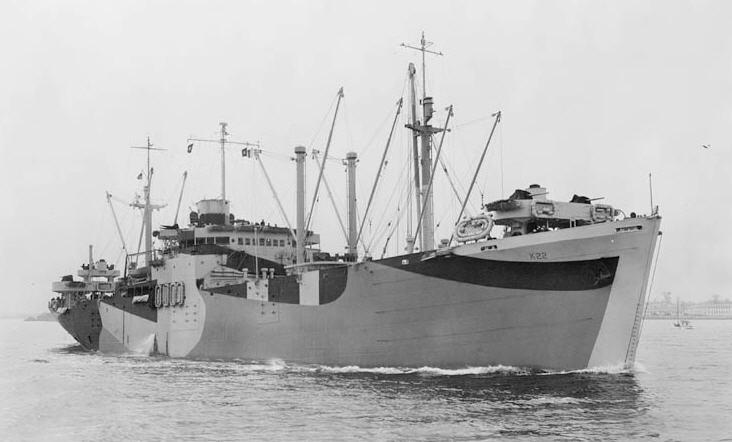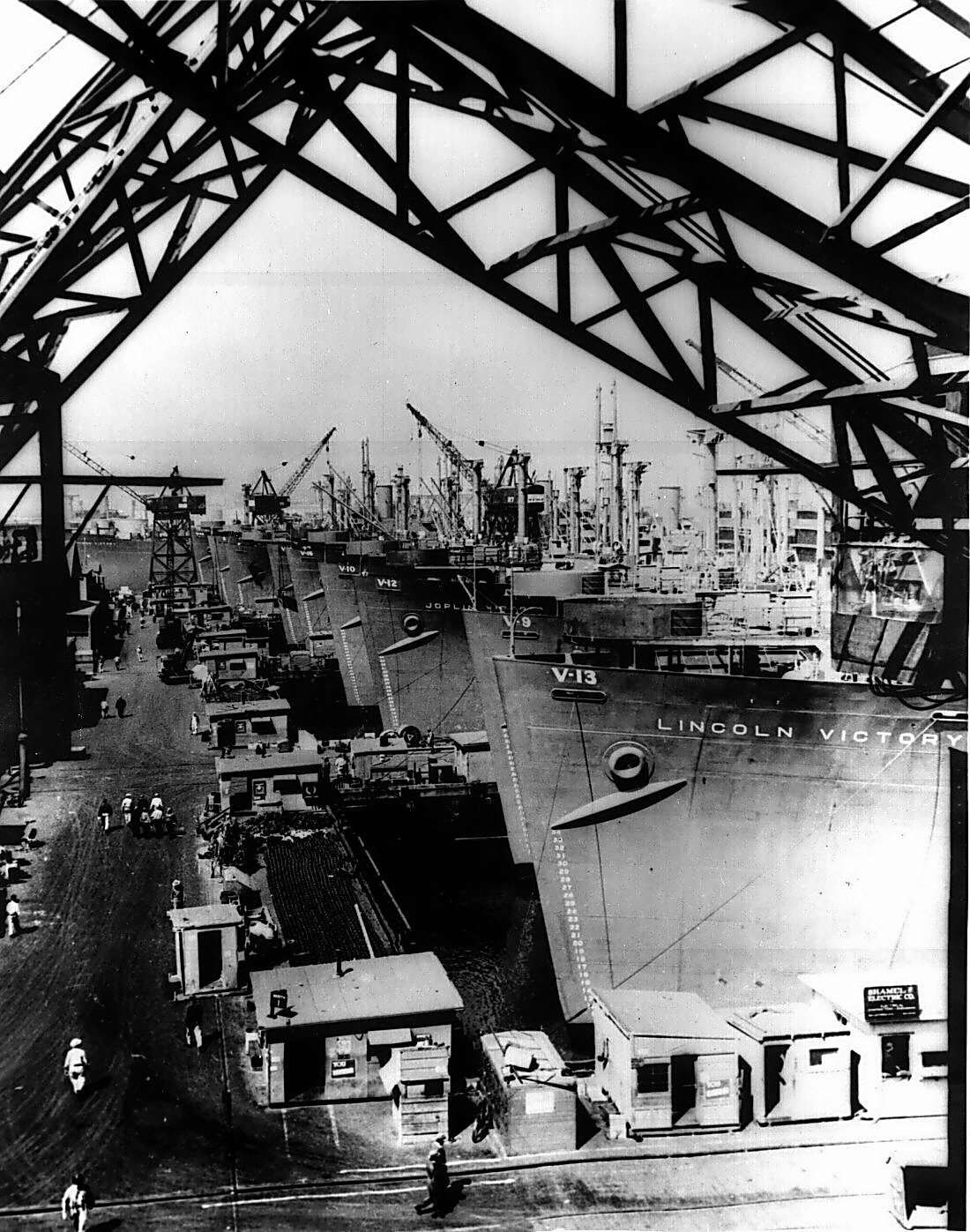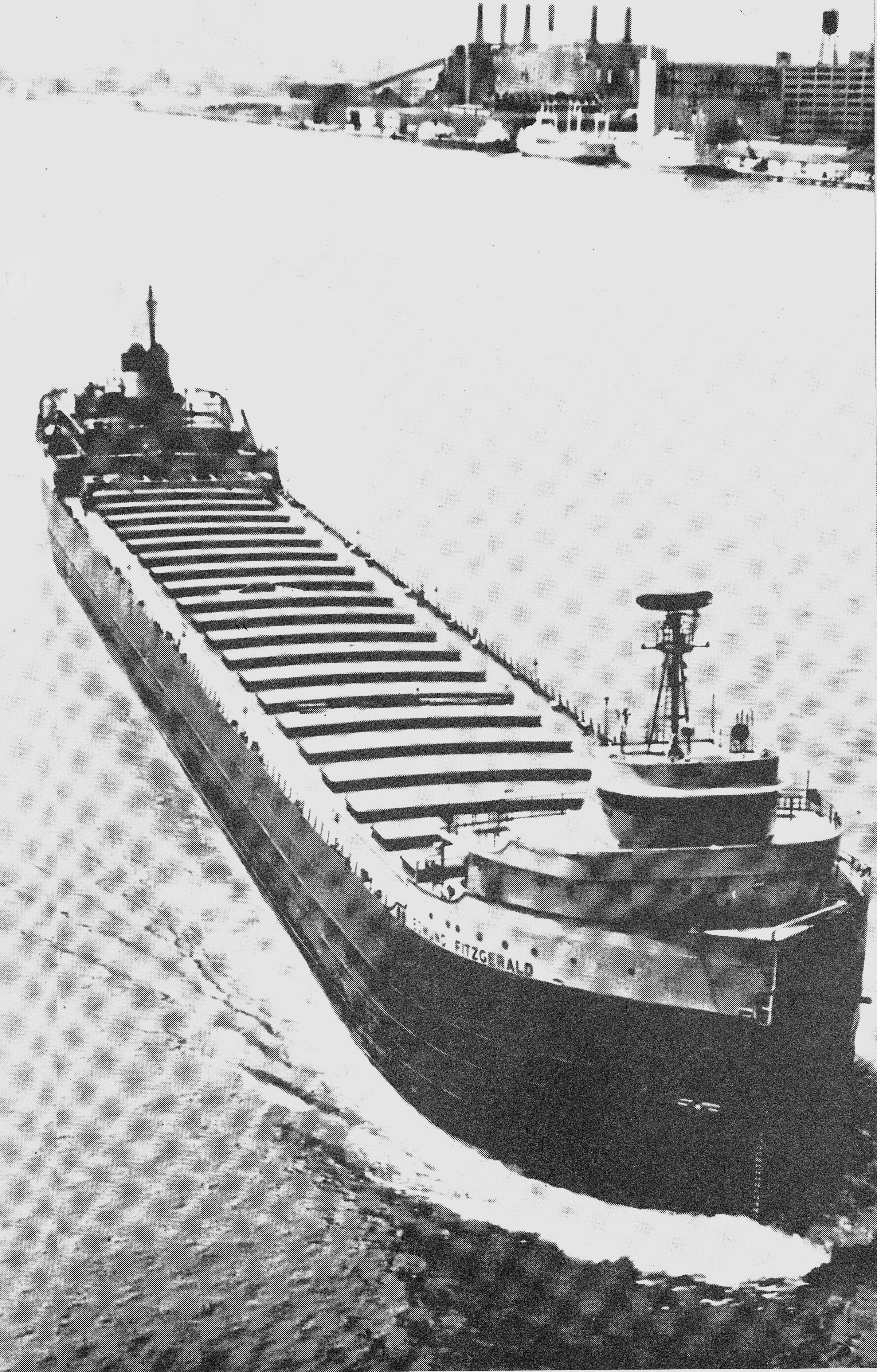|
L6-S-B1
The Type L6 ship is a United States Maritime Administration (MARAD) designation for World War II as a Great Lakes dry break bulk cargo ship. The L-Type Great Lakes Dry Bulk Cargo Ships were built in 1943 to carry much-needed iron ore from the upper Great Lakes to the steel and iron production facilities on Lakes Erie and Ontario in support of the war effort. The ships have a 15,675 tonne deadweight tonnage. The L6 ships were built by two companies: American Ship Building Company, in the case of the type L6-S-A1 models, of which 6 were built; and Great Lakes Engineering Works, Ashtabula, Ohio/ Great Lakes Engineering Works, River Rouge, Ohio, in the case of the type L6-S-B1, which produced 10 ships. Steel supply needed for World War was great. To supply iron ore from Lake Superior to steel foundries, the United States Commission had a series of L6 Lakers ship built. The Maritime Commission ordered ten Great Lakes Bulk Carriers of the L6-S-B1 type. The L6-S-B1 was design with a 3-c ... [...More Info...] [...Related Items...] OR: [Wikipedia] [Google] [Baidu] |
Great Lakes Engineering Works
The Great Lakes Engineering Works (GLEW) was a leading shipbuilding company with a shipyard in Ecorse, Michigan, that operated between 1902 and 1960. Within three years of its formation, it was building fifty percent of the tonnage of all ships in the Great Lakes. During World War II, GLEW was commissioned by Pittsburgh Steamship Company and the U.S. Maritime Commission to build twenty-one ore freighters. Its innovations included the first self-unloader freighter, SS ''Wyandotte''. GLEW is best known for its construction of the . History The GLEW was formed in 1902 to purchase Riverside Ironworks. Riverside was the short-lived successor to the venerable S.F. Hodge Company ( Samuel F. Hodge & Company), which was well known for quality steam engines and provided access not only to marine engine markets, but also to non marine markets as well. Because of the Hodge Company, which was founded in 1863, and other companies like them, the Detroit River community had become a hot ... [...More Info...] [...Related Items...] OR: [Wikipedia] [Google] [Baidu] |
SS Alpena (1942)
The SS ''Alpena'' (formerly the SS ''Leon Fraser'') is a lake freighter. She was built in 1942 by the Great Lakes Engineering Works in Ecorse, Michigan, to carry iron ore. She was originally owned by the Pittsburgh Steamship Company, a subsidiary of United States Steel. After also hauling grain in addition to ore in the 1960s and 1970s, the ship was put into storage in 1982. In 1989, the ship was purchased by Fraser Shipyards in Superior, Wisconsin, which shortened her by and converted her into a self-unloading cement carrier. In 1990, the ship was purchased by New Management Enterprises and renamed the ''Alpena'', which uses her to transport cement between Alpena, Michigan, and other Great Lakes cement ports. By 2015, she was the oldest active steamship on the Great Lakes. In December 2015, she was damaged by a fire while in a dry dock for an inspection. As of 2021, the ship is owned by Andrie Transportation Group and Inland Lakes Management. Ore carrier (SS ''Leon Fraser ... [...More Info...] [...Related Items...] OR: [Wikipedia] [Google] [Baidu] |
Taiwan
Taiwan, officially the Republic of China (ROC), is a country in East Asia, at the junction of the East and South China Seas in the northwestern Pacific Ocean, with the People's Republic of China (PRC) to the northwest, Japan to the northeast, and the Philippines to the south. The territories controlled by the ROC consist of 168 islands, with a combined area of . The main island of Taiwan, also known as ''Formosa'', has an area of , with mountain ranges dominating the eastern two-thirds and plains in the western third, where its highly urbanised population is concentrated. The capital, Taipei, forms along with New Taipei City and Keelung the largest metropolitan area of Taiwan. Other major cities include Taoyuan, Taichung, Tainan, and Kaohsiung. With around 23.9 million inhabitants, Taiwan is among the most densely populated countries in the world. Taiwan has been settled for at least 25,000 years. Ancestors of Taiwanese indigenous peoples settled the isla ... [...More Info...] [...Related Items...] OR: [Wikipedia] [Google] [Baidu] |
Merchant Ships Of The United States
A merchant is a person who trades in commodities produced by other people, especially one who trades with foreign countries. Historically, a merchant is anyone who is involved in business or trade. Merchants have operated for as long as industry, commerce, and trade have existed. In 16th-century Europe, two different terms for merchants emerged: referred to local traders (such as bakers and grocers) and ( nl, koopman) referred to merchants who operated on a global stage, importing and exporting goods over vast distances and offering added-value services such as credit and finance. The status of the merchant has varied during different periods of history and among different societies. In modern times, the term ''merchant'' has occasionally been used to refer to a businessperson or someone undertaking activities (commercial or industrial) for the purpose of generating profit, cash flow, sales, and revenue using a combination of human, financial, intellectual and physical capit ... [...More Info...] [...Related Items...] OR: [Wikipedia] [Google] [Baidu] |
List Of Auxiliaries Of The United States Navy
This is a list of auxiliaries of the United States Navy. It covers the various types of ships that support the frontline combat vessels of the United States Navy. Ship status is indicated as either currently active (including ready reserve), inactive or precommissioning Ships in the inactive category include only ships in the inactive reserve, ships which have been disposed from US service have no listed status. Ships in the precommissioning category include ships under construction or on order. Crane Ships (AB) * USS ''Kearsarge'' (AB-1), ex-BB-5 Colliers (AC) * USS ''Hannibal'' (1898) * USS ''Justin'' (1898) * USS ''Leonidas'' (1898) * USS ''Marcellus'' (1879) * USS ''Merrimac'' (1898) * USS ''Quincy'' (1918) * USS ''Saturn'' (1898) * USS ''Southery'' (1898) * USS ''Sterling'' (1898) * USS ''Vestal'' (AC-1), later AR-4 * USS ''Ontario'' (AC-2), later AR-3 * USS ''Jupiter'' (AC-3), later CV-1, AV-3 * USS ''Cyclops'' (AC-4), lost March 1918 * USS ''Vulcan' ... [...More Info...] [...Related Items...] OR: [Wikipedia] [Google] [Baidu] |
United States Merchant Marine Academy
The United States Merchant Marine Academy (USMMA or Kings Point) is a United States service academy in Kings Point, New York. It trains its midshipmen (as students at the academy are called) to serve as officers in the United States Merchant Marine, branches of the United States Armed Forces and the transportation industry. Midshipmen are trained in different fields such as marine engineering, navigation, ship's administration, maritime law, personnel management, international law, customs, and many other subjects important to the task of running a large ship. History Between 1874 and 1936, diverse federal legislation supported maritime training through school ships, internships at sea, and other methods. A disastrous fire in 1934 aboard the passenger ship SS ''Morro Castle'', in which 134 people died, convinced the U.S. Congress that direct federal involvement in efficient and standardized training was needed.* Originally — and in cooperation with the State of New Y ... [...More Info...] [...Related Items...] OR: [Wikipedia] [Google] [Baidu] |
Type C3 Ship
Type C3-class ships were the third type of cargo ship designed by the United States Maritime Commission (MARCOM) in the late 1930s. As it had done with the Type C1 ships and Type C2 ships, MARCOM circulated preliminary plans for comment. The design presented was not specific to any service or trade route, but was a general purpose ship that could be modified for specific uses. A total of 162 C3 ships were built from 1939 to 1946. The C3 was larger and faster than the C1 and C2 contemporaries, measuring from stem to stern (vs. for the C2), and designed to make (vs. for the C2). Like the C2, it had five cargo holds. A total of 465 of these ships were built between 1940 and 1947. A total of 75 ships were built with C3 hulls and engines, but not built as cargo ships. During World War II, many C3 ships were converted to naval uses, particularly as s, and as and s, ''Klondike''-class destroyer tenders, submarine tenders, and seaplane tenders. Ships in type *C3 DWT 12,595 as in ... [...More Info...] [...Related Items...] OR: [Wikipedia] [Google] [Baidu] |
Type C2 Ship
Type C2 ships were designed by the United States Maritime Commission (MARCOM) in 1937–38. They were all-purpose cargo ships with five holds, and U.S. shipyards built 328 of them from 1939 to 1945. Compared to ships built before 1939, the C2s were remarkable for their speed and fuel economy. Their design speed was , but some could make on occasion. The first C2s were long, broad, and deep, with a draft. Later ships varied somewhat in size. Some, intended for specific trade routes, were built with significant modifications in length and capacity. In 1937, MARCOM distributed tentative designs for criticism by shipbuilders, ship owners, and naval architects. The final designs incorporated many changes suggested by these constituencies. The ships were to be reasonably fast but economical cargo ships which, with some government subsidies to operators, could compete with vessels of other nations. Building costs were to be minimized by standardization of design and equipment, and t ... [...More Info...] [...Related Items...] OR: [Wikipedia] [Google] [Baidu] |
Type C1 Ship
Type C1 was a designation for small cargo ships built for the United States Maritime Commission before and during World War II. Total production was 493 ships built from 1940 to 1945. The first C1 types were the smallest of the three original Maritime Commission designs, meant for shorter routes where high speed and capacity were less important. Only a handful were delivered prior to Attack on Pearl Harbor, Pearl Harbor. But many C1-A and C1-B ships were already in the works and were delivered during 1942. Many were converted to military purposes including troop transports during the war. The Type C1-M ship was a separate design, for a significantly smaller and shallower Draft (hull), draft vessel. This design evolved as an answer for the projected needs for military transport and supply of the Pacific Ocean theater of World War II. Type C1 ships under the control of the British Ministry of War Transport took an Empire ship, Empire name even if built with another name e.g. ''C ... [...More Info...] [...Related Items...] OR: [Wikipedia] [Google] [Baidu] |
Liberty Ship
Liberty ships were a class of cargo ship built in the United States during World War II under the Emergency Shipbuilding Program. Though British in concept, the design was adopted by the United States for its simple, low-cost construction. Mass-produced on an unprecedented scale, the Liberty ship came to symbolize U.S. wartime industrial output. The class was developed to meet British orders for transports to replace ships that had been lost. Eighteen American shipyards built 2,710 Liberty ships between 1941 and 1945 (an average of three ships every two days), easily the largest number of ships ever produced to a single design. Their production mirrored (albeit on a much larger scale) the manufacture of "Hog Islander" and similar standardized ship types during World War I. The immensity of the effort, the number of ships built, the role of female workers in their construction, and the survival of some far longer than their original five-year design life combine to make them th ... [...More Info...] [...Related Items...] OR: [Wikipedia] [Google] [Baidu] |
Victory Ships
The Victory ship was a class of cargo ship produced in large numbers by North American shipyards during World War II to replace losses caused by German submarines. They were a more modern design compared to the earlier Liberty ship, were slightly larger and had more powerful steam turbine engines giving higher speed to allow participation in high speed convoys and make them more difficult targets for German U-boats. A total of 531 Victory ships were built in between 1944 and 1946. VC2 design One of the first acts of the United States War Shipping Administration upon its formation in February 1942 was to commission the design of what came to be known as the Victory class. Initially designated EC2-S-AP1, where EC2 = Emergency Cargo, type 2 (Load Waterline Length between ), S = steam propulsion with AP1 = one aft propeller (EC2-S-C1 had been the designation of the Liberty ship design), it was changed to VC2-S-AP1 before the name "Victory Ship" was officially adopted on 28 Apr ... [...More Info...] [...Related Items...] OR: [Wikipedia] [Google] [Baidu] |
SS Edmund Fitzgerald
SS ''Edmund Fitzgerald'' was an American Great Lakes freighter that sank in Lake Superior during a storm on November 10, 1975, with the loss of the entire crew of 29 men. When launched on June 7, 1958, she was the largest ship on North America's Great Lakes, and she remains the largest to have sunk there. She was located in deep water on November 14, 1975, by a U.S. Navy aircraft detecting magnetic anomalies, and found soon afterwards to be in two large pieces. For 17 years, ''Edmund Fitzgerald'' carried taconite iron ore from mines near Duluth, Minnesota, to iron works in Detroit, Michigan; Toledo, Ohio; and other Great Lakes ports. As a workhorse, she set seasonal haul records six times, often breaking her own record. Captain Peter Pulcer was known for piping music day or night over the ship's intercom while passing through the St. Clair and Detroit rivers (between lakes Huron and Erie), and entertaining spectators at the Soo Locks (between Lakes Superior and Huron) w ... [...More Info...] [...Related Items...] OR: [Wikipedia] [Google] [Baidu] |








